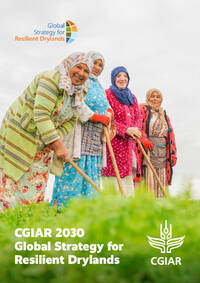CGIAR 2030 Global Strategy for Resilient Drylands

Authors:
CGIAR is dedicated to creating a world where sustainable and resilient agrifood systems provide safe, healthy, and affordable diets, improve livelihoods, and ensure greater social equality while keeping within environmentally sustainable boundaries . Transforming dryland food, land, and water systems in a climate crisis through science and innovation is crucial for achieving this mission.
Drylands cover 46% of the world’s land , are home to around 38% of the global population, and support nearly 44% of the world’s agricultural systems, including half of its livestock . The drylands - already challenging areas for predictable food production - face mounting pressures from extreme climate change and variability, water scarcity, land degradation, and loss of the biodiversity and ecosystem services that support agrifood systems. Our efforts must keep pace with these challenges, for the sake of the current drylands, and for the areas that may turn into drylands in the future as the impacts of climate change become ever more evident.
The CGIAR 2030 Global Strategy for Resilient Drylands has been developed to align with the 2030 CGIAR Research and Innovation Strategy. It presents the informed and coordinated approach that CGIAR will take to contribute to the sustainable and resilient transformation of dryland agrifood systems, building on our unique value proposition and track record of co-creating and co-delivering innovative research and impact in the drylands. It also aligns with the United Nations Convention to Combat Desertification (UNCCD), the United Nations Convention on Biological Diversity (UNCBD), and the United Nations Framework Convention on Climate Change (UNFCCC).
This strategy was developed through extensive consultations with stakeholders across CGIAR and our partner network, informed by research and a foresight study on future global dryland scenarios. This process brought together expertise across CGIAR Centers, our partners, countries, and disciplines to build consensus on the opportunities and challenges to realizing our vision. As a result, five key opportunities for dryland transformation and investment were prioritized: (1) optimized agrifood systems for climate adaptation; (2) conserving and using biodiversity for community and ecosystem resilience; (3) managing soil, land, and water systems for sustainable production; (4) ensuring access to sustainable, healthy diets to alleviate hunger and malnutrition; and (5) translating evidence-based approaches into policy for development.
Underpinning these opportunities are our cross-cutting approaches to gender equality, youth, and social inclusion; innovation, scaling and adoption; working in fragile and conflict-affected areas; and partnerships and advocacy. Through a coordinated systems approach, we will pool our capacity and expertise, including through our diverse network of partners, to move beyond incremental change and towards structural transformation for dryland communities.
